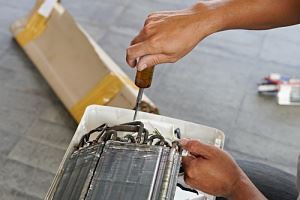Presidential Heating & Air Conditioning
Gaithersburg HVAC Contractors
Share
Share on FacebookTweet
Tweet this0Share
Share on LinkedIn0 shares on LinkedInNo one wants to wake up in the middle of a cold winter night only to discover their home heating system has stopped working. It needs your immediate attention in less than ideal circumstances.
 One way to prevent this from happening is to keep up with the maintenance of your system. That means having a professional HVAC technician inspect it each fall and perform routine service. By doing this, you will be able to avoid most major malfunctions by making minor repairs before problems occur.
One way to prevent this from happening is to keep up with the maintenance of your system. That means having a professional HVAC technician inspect it each fall and perform routine service. By doing this, you will be able to avoid most major malfunctions by making minor repairs before problems occur.
Troubleshooting When Your Heat Goes Off
Nonetheless, an occasional system outage can happen. Before you call your HVAC technician, consider troubleshooting it yourself with these helpful tips.
Check Your Breakers and Shut-Off Switches
It’s not unusual for a problem to be simply a tripped circuit breaker or a switch that has been turned off. Make sure all power switches are “on.” The furnace power switch is typically located on the furnace itself or on a nearby wall. Flip the switch and see if power returns to the furnace.
Also, check the front panel that covers the blower. In some models, you need to make sure the panel is shut tightly. A switch under the panel needs to be depressed before the furnace will turn on.
If you have a gas furnace, look for a gas valve on the gas line. It may have been turned off by someone and not turned back on. If you find a handle that’s perpendicular to the gas pipe, turn it to the “on” position. In the “on” position, the handle will be parallel to the gas line.
If you have an older model furnace, check that the pilot light is still lit. If you have a newer model, it probably has a system using flashing lights that tells you the furnace’s operational status. A sequence of flashing lights or numerical code can tell you if the home heating system is getting power or has a mechanical or technical problem that is interfering with its proper operation. Refer to the furnace’s operator manual or access panel for the key that explains the code’s meaning and recommended solutions.
Check the Thermostat
Roughly one quarter of furnace repair calls turn out to be problems with the thermostat, not the furnace. Make sure the thermostat is operating and the settings are in the proper position. When more than one person resides in the house, it’s not unusual for someone to change the settings. Make sure the “heat” switch is in the “on” position. If your blower won’t stop running, make sure the fan setting is not stuck in the “on” position. Instead, switch it to “auto.”
Make sure the thermostat is set to the temperature setting you prefer. If you have a programmable thermostat, check the other settings to make sure the thermostat is communicating correctly with the furnace. For example, if the date and time are not accurate on the display, correcting it may cause the furnace to turn on and off at the right times.
If the thermostat is battery-operated, the batteries should be changed once a year. Consider changing the batteries the first time you turn on the furnace every year to make the task easy to remember.
You can also bypass the program features by setting the thermostat to “manual” and “heat.” Then adjust the temperature to at least 5° higher than the current room temperature and listen for the furnace to start. If it does, your thermostat is probably faulty and may need to be replaced.
Consider opening the thermostat to gently blow out any dust or dirt that has accumulated over time.
Change the Air Filters
Overly dirty and clogged air filters can cause your furnace to malfunction. Dirty filters block airflow, which causes the heat exchanger to overheat and shut off before your house has a chance to warm up. A dirty filter can cause soot to build up on the heat exchanger, which causes two problems. First, it impairs the operating efficiency of the furnace and, second, over time, it shortens the life of the furnace. If no light shines through when you hold the filter up to the light, the filter needs to be changed. Ideally, you should change the air filters monthly.
Clear the Drain Lines
It’s not unusual for drain lines to become clogged. If your furnace is a newer model, be aware that high-efficiency furnaces can drain off several gallons of water a day in the wintertime. When drain lines become clogged, the furnace will shut down.
Flushing the drain lines is easy. Simply remove the hose, fill it with a mixture of 25% bleach and 75% water. Let it sit for a few minutes, then rinse it well.
Clear Debris From External Components and Vents Outside Your Home
Check any components and vents located outside your house. Make sure there is no debris or object interfering with operating components or blocking vents, intake openings or exhaust vents. Clean or replace any mesh covering the pipe openings. If you see ice clogging one of the pipes, your problem could be somewhere inside the system. You will need to call your HVAC professional to diagnose this problem.
If you have a heat pump, make sure nothing is building up on the fins of the outdoor compressor unit. It is a good idea to hose it down carefully before the cold weather arrives and clean off dirt and debris.
Important: If you smell gas or suspect a leak, you should leave the home and call your gas utility. You should not try to correct this yourself.
Contact Presidential Heating and Air for More Information
Before the cold months arrive, you should have an HVAC expert inspect your home heating system. The HVAC expert will inspect your furnace and clean the components. If new parts are needed, it is a good time to replace them. An inspection by a professional HVAC technician can often detect lurking furnace problems and repair them before they become major repairs. Contact Presidential Heating and Air to schedule an inspection of your furnace before winter sets in.


